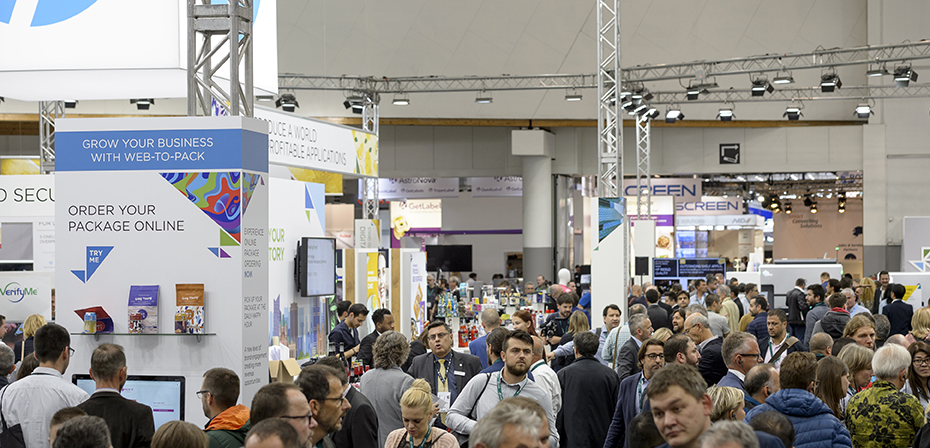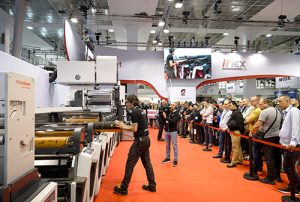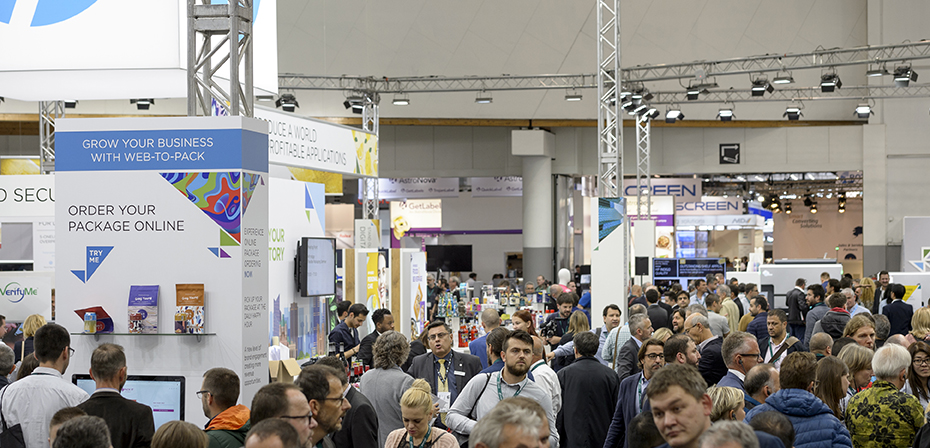There was the flexo technology largely used for labels, plus advances in the hybrid technologies and flexible packaging. These were the key focus of the 2019 edition, reflecting the theme “Move your business forward”
 Spread over nine halls and covering almost 40,000 sqm of floorspace, up from 37,600 sqm in 2017, the show presented the largest offering of label and package printing technologies and live demonstrations seen to date. This included the fast growing areas of hybrid printing, flexible packaging and automation. Poor weather didn’t deter 37,903 visitors from 140 countries flocking to the four-day show – a substantial increase on 125 in 2017. India, China and Japan were especially well represented with large visitor delegations. Eastern Europe also showed a stronger representation compared to 2017, in particular Croatia, with a 51 percent increase, Lithuania (36 percent), Romania (25 percent), and Russia (14 percent). Brazil also saw a 14 percent increase on visitors compared to 2017.
Spread over nine halls and covering almost 40,000 sqm of floorspace, up from 37,600 sqm in 2017, the show presented the largest offering of label and package printing technologies and live demonstrations seen to date. This included the fast growing areas of hybrid printing, flexible packaging and automation. Poor weather didn’t deter 37,903 visitors from 140 countries flocking to the four-day show – a substantial increase on 125 in 2017. India, China and Japan were especially well represented with large visitor delegations. Eastern Europe also showed a stronger representation compared to 2017, in particular Croatia, with a 51 percent increase, Lithuania (36 percent), Romania (25 percent), and Russia (14 percent). Brazil also saw a 14 percent increase on visitors compared to 2017.
Major press manufacturers announced multiple sales on a daily basis, including: Domino’s 7-color N610i inkjet press sold to a Belgian converter on day one; Lombardi’s sale of five Synchroline 430 presses during the first two days of the show; Gallus’ sale of three presses into India; Konica Minolta’s AccurioLabel 230 toner label press, sold on day one and which also debuted at the show; Grafisk Maskinfabrik’s DC350 digital converting line and a SR350 inspection slitter rewinder sold to a UK converter; Grafotronic’s laser die-cutting system sold to an American label converter after launching the machine at the show; and Screen’s first Trupress sold into Germany.
Indian machine manufacturers did particularly well, with UV Graphic Technologies selling seven Ultraflex UFO presses, Multitec selling its full servo S1 press to a Russian converter, and Monotech Systems selling three Colornovo presses, one each in China, Europe and Asia.
Chinese manufacturers also fared well, with sales highlights including label press manufacturer Wanjie’s sale of a printer to a converter in Spain. Rhyguan sold three finishing systems on day one – one to an Italian converter and two to companies in Germany.
Hybrid technology leads the forward
In the narrow-web sector of flexo that’s largely used for labels, many of the advances were in the hybrid technologies that integrate a digital print engine onto a modified flexo press chassis that provides the material transport and can also incorporate conventional flexo, screen and finishing units inline. This is leading to a shift in emphasis to mid-widths for pure flexo presses. And so, the pure flexo technology is moving to mid-web widths of 510, 560, 580mm, for non-hybrids.
There were lot of other trends that was detected. Using water-based ink will be more and more important. But we also see, for example, in the case of flexo printing, the plastic film become a challenging task. Then there is the request for reduction of solvents. This is increasing, not only in Europe but also in Asia.
Baldwin reckons that food packaging is the weak spot for inkjets. Xeikon dry toner and HP Indigo liquid toner digital presses have food-safe inks, but they are much slower than UV-cure inkjets. Baldwin says: “With inkjet, even with an approved low-migration ink, over a certain amount of coverage it isn’t going to pass the migration test. It’s a matter of how much uncured photo-initiators and other components are left in that volume, which is much more than in a thin flexo ink film.
This is where flexo can still outdo digital, in the mid-web arena. You can use barrier films and things with digital, but the best way is just to go flexo.”
Digital technology at Labelexpo
Speaking of digital, Konica Minolta team announced the 450th installation worldwide of their AccurioLabel toner presses. A key official of Konica Minolta said, “As we continue our growth, of course, there will continue to be more installations across the world, including within India, but we don’t break down those figures by country. What we do know is that research predicts a massive growth in the development of installed bases for digital colour label printers over the next few years, which shows no signs of slowing down. Figures from Keypoint Intelligence show that in the market there were just under 4,000 digital colour label printer installations in 2017, a figure the research group predicts will rise to almost 7,500 units by 2022.”
It makes sense. Digital has no plate costs, but when you look at inkjet inks, it costs three to four times as much as flexo.
Multi-developer Revo alliance comprising Bobst (flexo presses), Esko (pre-press workflows), DuPont (flexo plates), X-Rite (colour measurement instruments), AVT (verification systems), Apex International (anilox rollers), Flint Group (inks) and UPM Raflatacs (label materials) have been developing in this area since 2013.
Ink-on-Demand
In April 2019, Bobst announced what the “last mile” in the digital flexo project, a new inking system called Ink-on-Demand (IoD). This replaces the standard flexo unit’s ink tray with a digitally controlled ink dispensing system and automatic wash-up. The result is a dramatic reduction in the amount of ink circulating in the system. How little? Well it using just 30g of ink compared to 1.5 litres in a conventional ink tray system.
This makes it much quicker and cheaper to change special ink colours between jobs. However, it also fits in with another Revo system, which uses a ‘fixed duct’ seven-colour process ink set, instead of special colours.
The Digital Printbar
There also was the Digital Printbar at two stands, Gallus and Nilpeter. Explaining the reason for having a Digital Printbar, Samir Patkar, managing director, Gallus Heidelberg India, said, “If you look at the label application, it is filmic, self-adhesive. So how does the printer address this? He will first print a screen white as the base, then overprint using flexo on top of the white. What some other printers do is they give two shots of white on the flexo units. Now if you do, let’s say screen, there no distortion but it’s expensive, plus there’s the time-consuming repro side of it. If you take the Printbar for instance, it is on a fixed position right now, though it will eventually go on a rail. Now you can print the white with inkjet, and it goes on a fly. It eliminates the repro side of using screen.”
The Digital Printbar will be available early next year, and the top-end kit will cost Euro 2,50,000, which is a bit expensive. Yes, of course, it is a bit expensive to invest in a Printbar like that, but when you look at the life cycle, you don’t need screens at all. So, all the consumables you use, and the repro time, are all savings, said Patkar.
Meanwhile Edale (which has a couple of installations in India) has developed its own AiiR technology for its FL3 and FL5 flexo presses, standing for Autonomous, Inking, Impression and Registration. It is a camera-based, closed loop inspection system which will bring the print into register without operator input.
Flexo Plate making

This brings us to flexo platemaking. Even today, it is often handled by outside service houses, but fast turnround flexo will inevitably drive demand for more plates, more quickly.
Chemistry-free thermal processing using heat and an absorbent blanket to remove uncured polymer is a much faster alternative to solvent washout. This process was originally introduced by DuPont in 2002 with its FAST system. Others followed, such as MacDermid with LAVA, and Flint with nyloflex Xpress. No drying is required, although a final UV blast is still needed to de-tack the polymer.
Aqueous washout is the main fast alternative, though favoured more in Japan and the Far-East than in Europe and North America. This uses hot air knife drying and is quicker than solvent washout as water isn’t absorbed by the polymer. It allows very small highlight dots and is better than thermal (although that’s improving). Asahi is the main promoter of aqueous plates in Europe, with its Flenex range.
Both thermal and aqueous plates can be laser imaged and processed in less than 90 minutes. Once produced, plates can be re-used, with up to four runs being typical.
Digital platesetters for flexo mostly use powerful lasers to ablate a LAM (laser ablation mask) that is factory-applied to the plate surface. Kodak’s Flexcel NX system – now sold by spin-off business Miraclon – is different in that it images a film the ‘thermal imaging layer’ of which is subsequently laminated onto a bare plate. Either way, after imaging the plate is exposed to UV light top and bottom to harden it, and then processed to remove unhardened polymer.
Esko’s CDI XLS Crystal range is suited to in-house use. It combines a CDI LAM laser platesetter with automatic transfer to an Esko LED UV exposure unit for both back and top layers. An Esko official told PrintWeek that “Printers don’t want to fiddle with curves and tuning UV energy and lasers. It has to be a simple process, a one-button solution where a plate comes out and they have to be able to trust it. These people are paid for the printed plastic they ship, not the plates they make.”
As HB Fuller said, “With the growth of e-retail, this means more products are being shipped and more logistic labels are needed. Additionally, direct print to the corrugated box doesn’t offer excellent scannability and logistic labels are preferred. This market increase also means faster and longer-distance transportation, so labels have to be prepared to withstand different climate zones throughout the journey.”



